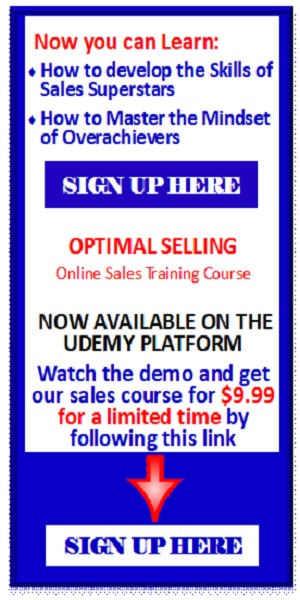 You are going to succeed at networking events from this point forward. You are going to leave behind the “me-centered” approach and now become “people-centered”. Instead of being like all the other guests, trying to talk about themselves, you are going to walk in the door with the goal to listen to other people’s stories. You are going to let them talk, telling you about their lives and their business. Guess what? Chances are great that they are going to share their pain indicators, the business problems that keep them up at night. Impressed by how you have let them talk and how well you have listened, they will get around to asking you what you do. Your answer? “I provide solutions to the very problems you just described. Let me tell you how I can help.”
You are going to succeed at networking events from this point forward. You are going to leave behind the “me-centered” approach and now become “people-centered”. Instead of being like all the other guests, trying to talk about themselves, you are going to walk in the door with the goal to listen to other people’s stories. You are going to let them talk, telling you about their lives and their business. Guess what? Chances are great that they are going to share their pain indicators, the business problems that keep them up at night. Impressed by how you have let them talk and how well you have listened, they will get around to asking you what you do. Your answer? “I provide solutions to the very problems you just described. Let me tell you how I can help.”
Make networking less like work!
Beware of Weasel Words
 Don’t use weasel words like “maybe”, “probably”, or “I think so”. Don’t let your prospects get away with using them either. Imagine your son coming home and announcing, with great excitement, that he had proposed marriage to his girlfriend and she had said “maybe”. Maybe? What did she mean by “maybe”? That doesn’t sound like a woman who wants to marry your son, does it? In a sales situation, weasel words like “maybe”, “probably”, “I think so”, or “usually” are just as much red flags as the words of the girl who broke your son’s heart. A prospect who uses such words is a prospect who is saying “You have NOT convinced me to buy your product or service but I’m too afraid to tell you.” This is the time for you to ask some questions of the prospect. What do you mean by “maybe”? Can you explain how this situation may be “unusual” for you? What are the decision factors you are thinking about? Seek clarity, conciseness, and directness – not only from yourself but also from your prospect.
Don’t use weasel words like “maybe”, “probably”, or “I think so”. Don’t let your prospects get away with using them either. Imagine your son coming home and announcing, with great excitement, that he had proposed marriage to his girlfriend and she had said “maybe”. Maybe? What did she mean by “maybe”? That doesn’t sound like a woman who wants to marry your son, does it? In a sales situation, weasel words like “maybe”, “probably”, “I think so”, or “usually” are just as much red flags as the words of the girl who broke your son’s heart. A prospect who uses such words is a prospect who is saying “You have NOT convinced me to buy your product or service but I’m too afraid to tell you.” This is the time for you to ask some questions of the prospect. What do you mean by “maybe”? Can you explain how this situation may be “unusual” for you? What are the decision factors you are thinking about? Seek clarity, conciseness, and directness – not only from yourself but also from your prospect.
Are you selling today? If not, why not?
 Don’t get out of shape – spend 20 minutes every day making calls. You are an NFL quarterback. You suffer an injury that keeps you out of the league for two years. Will you be sharp in the first meaningful game you play upon your return, ready to perform your absolute best? Unlikely. You’ll need time to get yourself acclimated to the speed and intensity of NFL regular season football. Your team’s offense may struggle and your team may lose because you are out of sync. The lesson? Don’t be “injured” from the daily game of calling prospects! You cannot afford for even one day to go by without sales calls. You’ll get out of shape. One day becomes two days which becomes a week. Suddenly, you haven’t made a call in three weeks and you’ve lost your rhythmn and your confidence. Stay in the game every day!
Don’t get out of shape – spend 20 minutes every day making calls. You are an NFL quarterback. You suffer an injury that keeps you out of the league for two years. Will you be sharp in the first meaningful game you play upon your return, ready to perform your absolute best? Unlikely. You’ll need time to get yourself acclimated to the speed and intensity of NFL regular season football. Your team’s offense may struggle and your team may lose because you are out of sync. The lesson? Don’t be “injured” from the daily game of calling prospects! You cannot afford for even one day to go by without sales calls. You’ll get out of shape. One day becomes two days which becomes a week. Suddenly, you haven’t made a call in three weeks and you’ve lost your rhythmn and your confidence. Stay in the game every day!
Embrace the No
 What is the second most wonderful word in sales? “No”! Every no leaves you one step closer to a “yes”! If your rate is to close 1 out of 5 prospects, four “no”s mean your next prospect is a sale (statistically speaking)! Imagine a baseball field. First, second, and third base represent prospects saying “no”. Home plate is a “yes”! As you round third on your inside-the-park sales homerun, you are excited to be a few feet from a sale – home plate! The other bases, where the prospects said “no”, were part of the game you had to play. Don’t get depressed that you have to run the bases as the ball you hit goes to the fence. Run those bases! Get those “no”s! Embrace the “no” because you soon will be scoring a run!
What is the second most wonderful word in sales? “No”! Every no leaves you one step closer to a “yes”! If your rate is to close 1 out of 5 prospects, four “no”s mean your next prospect is a sale (statistically speaking)! Imagine a baseball field. First, second, and third base represent prospects saying “no”. Home plate is a “yes”! As you round third on your inside-the-park sales homerun, you are excited to be a few feet from a sale – home plate! The other bases, where the prospects said “no”, were part of the game you had to play. Don’t get depressed that you have to run the bases as the ball you hit goes to the fence. Run those bases! Get those “no”s! Embrace the “no” because you soon will be scoring a run!
Have Elevator Questions
 The proverbial elevator pitch should be replaced by elevator questions. No one wants to hear a pitch … EVER! The easiest way to start a conversation in networking situations, chamber events, and yes even elevators is to ask questions. It can be innocuous (like “Did you go to Harvard or just liked the T-Shirt?”), or it can be business oriented (So what do you do?) In either case you get the conversation going by focusing on them and then you can lead it to a discussion of issues they may be having that you can help with. Eventually you will get a chance to tell them what you do and, magically, it will be right on target and help you create a connection and possibly a new client.
The proverbial elevator pitch should be replaced by elevator questions. No one wants to hear a pitch … EVER! The easiest way to start a conversation in networking situations, chamber events, and yes even elevators is to ask questions. It can be innocuous (like “Did you go to Harvard or just liked the T-Shirt?”), or it can be business oriented (So what do you do?) In either case you get the conversation going by focusing on them and then you can lead it to a discussion of issues they may be having that you can help with. Eventually you will get a chance to tell them what you do and, magically, it will be right on target and help you create a connection and possibly a new client.
Beware of Personal Presence
 Body language speaks louder than the words you utter and your beliefs affect your body language. If you want to be more persuasive, project a stronger image. If you want to project a stronger image you he to have a strong belief in yourself and what you are saying. Any self-limiting beliefs you have will detract from your belief in yourself and what you are trying to get the prospect to believe. So in order to be a more effective at persuading, you need to understand your hidden self-limiting beliefs and work to overcome them. in that way the prospect will get a stronger “pre-sense” of who they are dealing with.
Body language speaks louder than the words you utter and your beliefs affect your body language. If you want to be more persuasive, project a stronger image. If you want to project a stronger image you he to have a strong belief in yourself and what you are saying. Any self-limiting beliefs you have will detract from your belief in yourself and what you are trying to get the prospect to believe. So in order to be a more effective at persuading, you need to understand your hidden self-limiting beliefs and work to overcome them. in that way the prospect will get a stronger “pre-sense” of who they are dealing with.
Does your “techie” know when to talk?
 Have you ever had a technical person take over a sales call? Talk at inopportune times? Say the wrong thing? Tell the prospect he didn’t know what he was talking about? Derail a sales call for you? Interrupt the close? If you haven’t you are in a very small minority. The problem does not lie with the technical person it lies with the sales person. After all, the technical person can’t be expected to know how to sell just as you can’t be expected to know all the technical details. Furthermore, they don’t know where you are in the sales process, what the goal of the sales call is, what the prospect needs to hear technically, what they don’t need to hear technically, what outcome you are expecting … unless you tell them! You should tell them all of this before the call and most importantly you need to tell them when to talk and when not to talk. Take control of the sales call and you will never be surprised by the techie or have your sales call derailed by her.
Have you ever had a technical person take over a sales call? Talk at inopportune times? Say the wrong thing? Tell the prospect he didn’t know what he was talking about? Derail a sales call for you? Interrupt the close? If you haven’t you are in a very small minority. The problem does not lie with the technical person it lies with the sales person. After all, the technical person can’t be expected to know how to sell just as you can’t be expected to know all the technical details. Furthermore, they don’t know where you are in the sales process, what the goal of the sales call is, what the prospect needs to hear technically, what they don’t need to hear technically, what outcome you are expecting … unless you tell them! You should tell them all of this before the call and most importantly you need to tell them when to talk and when not to talk. Take control of the sales call and you will never be surprised by the techie or have your sales call derailed by her.
Ask the prospect when to followup
 Ask the prospect when you should follow up. Most follow up is a waste of time. However, even when it is warranted, it can be neve wracking trying to decide how soon to follow up or how often without seeming like a pest. To alleviate this problem just ask the prospect when you should follow up and for good measure ask what will happen when you do. And if you are really on the ball you might say something like “You know George, even if you are not ready to move to the next step on Tuesday when I call, could you be sure to answer my call or get back to me and let me know the length of the delay so that I don’t keep pestering you”. Doing this will make you seem more professional and will save you lots of time and be much easier on your nerves.
Ask the prospect when you should follow up. Most follow up is a waste of time. However, even when it is warranted, it can be neve wracking trying to decide how soon to follow up or how often without seeming like a pest. To alleviate this problem just ask the prospect when you should follow up and for good measure ask what will happen when you do. And if you are really on the ball you might say something like “You know George, even if you are not ready to move to the next step on Tuesday when I call, could you be sure to answer my call or get back to me and let me know the length of the delay so that I don’t keep pestering you”. Doing this will make you seem more professional and will save you lots of time and be much easier on your nerves.
Go For a No
 No is the second best word in sales. The worst is thing is a no preceded by a whole bunch of put-offs. When the prospect gets stuck or goes silent on you the best strategy is to go for a no. the video explains the wording but the strategy is to gently and respectfully suggest to the prospect that since we are not moving forward, they must have decided that it is over and therefore you are closing the file. If you are committed to getting either moving forward or getting a no at this time then you are happy either way. You have one less person who wasn’t going to buy to follow up with or you have moved the prospect forward. The side benefit is that you have a healthier more accurate pipeline. To make the technique work you have to be willing to let go of a prospect you might previously had high hopes for.
No is the second best word in sales. The worst is thing is a no preceded by a whole bunch of put-offs. When the prospect gets stuck or goes silent on you the best strategy is to go for a no. the video explains the wording but the strategy is to gently and respectfully suggest to the prospect that since we are not moving forward, they must have decided that it is over and therefore you are closing the file. If you are committed to getting either moving forward or getting a no at this time then you are happy either way. You have one less person who wasn’t going to buy to follow up with or you have moved the prospect forward. The side benefit is that you have a healthier more accurate pipeline. To make the technique work you have to be willing to let go of a prospect you might previously had high hopes for.
Moments of Value
 There are brief moments of value in a sales encounter when the prospect realizes that “this makes sense” or “I never thought of that” or “He really understands the issue and therefore might have a solution”. Sometimes it comes on the prospect gradually and sometimes it hits the prospect suddenly. But in either case, the opportunity to provide value originates in the questions you ask the prospect. Sometimes the questions themselves provide the value. It usually only takes a few minutes at most to provide that critical nugget that turns the encounter form a “sales call” to a discussion with a “trusted advisor”. The prospect wants more and the sales happens. Of course there is more to it than that and it might take months to complete the sale but it is that moment of value that makes the difference.
There are brief moments of value in a sales encounter when the prospect realizes that “this makes sense” or “I never thought of that” or “He really understands the issue and therefore might have a solution”. Sometimes it comes on the prospect gradually and sometimes it hits the prospect suddenly. But in either case, the opportunity to provide value originates in the questions you ask the prospect. Sometimes the questions themselves provide the value. It usually only takes a few minutes at most to provide that critical nugget that turns the encounter form a “sales call” to a discussion with a “trusted advisor”. The prospect wants more and the sales happens. Of course there is more to it than that and it might take months to complete the sale but it is that moment of value that makes the difference.

